Green 21v Blue 27v Red 33v
Mechanical keyboards are defined by their switches. In the Filco Majestouch-2 and many others, it is Cherry MX switches that are used. In this article, we'll look at the many different kinds of Cherry switches on the market and see how they compare to one another.
A potted history of Cherry
Cherry Corporation was founded in the United States in 1953 and started producing keyboards in 1967, making them the oldest keyboard manufacturer in the world that's still in business. The company was moved to Germany in 1967 and bought by ZF Friedrichshafen AG in 2008, but keyboards and mechanical switches are still produced under the Cherry brand.
Their most popular line of switches, the Cherry MX series, was introduced around 1985. These switches are usually referenced by their physical colour, with each colour denoting the switch's handling characteristics – whether it is clicky, whether it is tactile, and how much force is required to actuate the switch, in centi-Newtons (cN) or grams (g).
Now that we've explained a bit of the background information, we can have a look at the switches themselves – starting with the four most common varieties.
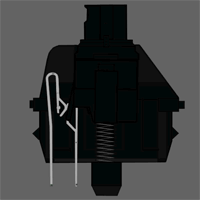
Linear switches
Linear switches have the simplest operation, moving straight up and down without any additional tactile feedback or loud clicking noise – we'll come to these more complicated switches later on. There are two common types of linear switches – Black and Red.
Cherry MX Black switches were introduced in 1984, making them one of the older Cherry switches. They have a medium to high actuation force, at 60 cN, which means they are the stiffest of the four most common Cherry switches. These switches are used in point-of-sale stations, but typically aren't considered ideal for typing due to their high weighting. They have found use in RTS video games, where the high weighting can prevent accidental key presses that might occur on less stiff switches. The stronger spring also means that they rebound faster, meaning they can be actuated quite quickly given enough force – although you may also find fatigue becomes more of a factor than with other switches.
See Cherry MX Black keyboards here >
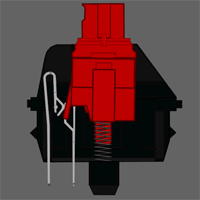 Conversely, Cherry MX Red switches were only introduced in 2008 and are the most recent switch to be developed by the company. They have a low actuation force, at 45 cN – tied with Brown for the lowest of the four most common switches. Red switches have been marketed as a gaming switch, with the light weighting allowing for more rapid actuation, and have become increasingly common in gaming keyboards.
Conversely, Cherry MX Red switches were only introduced in 2008 and are the most recent switch to be developed by the company. They have a low actuation force, at 45 cN – tied with Brown for the lowest of the four most common switches. Red switches have been marketed as a gaming switch, with the light weighting allowing for more rapid actuation, and have become increasingly common in gaming keyboards.
See Cherry MX Red keyboards here >
Tactile, non-clicky switches
Tactile switches provide, as the name suggests, additional tactile feedback as the key actuates. As you press the key down, there is a noticeable bump which lets you know that your key press has been registered.
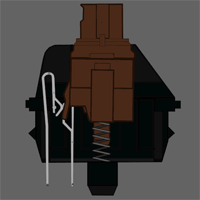 The most popular type of tactile, non-clicky switch is the Cherry MX Brown. This switch was introduced in 1994 as a special 'ergo soft' switch, but quickly became one of the most popular switches. Today, the majority of Filco keyboards are sold with Brown switches, as the switch is a good middle-of-the-road option appropriate for both typing and gaming. They are also ideal for typing in office environments, where a clicky switch might annoy some.
The most popular type of tactile, non-clicky switch is the Cherry MX Brown. This switch was introduced in 1994 as a special 'ergo soft' switch, but quickly became one of the most popular switches. Today, the majority of Filco keyboards are sold with Brown switches, as the switch is a good middle-of-the-road option appropriate for both typing and gaming. They are also ideal for typing in office environments, where a clicky switch might annoy some.
See Cherry MX Brown keyboards here >
Tactile, clicky switches
Clicky switches add a deliberately louder 'click' sound to the existing tactile bump, allowing for greater typing feedback. This makes it easier to know that you've hit the activation point. This is achieved by a more complicated mechanism, with a blue plunger and a white slider. When the actuation point is reached, the slider is propelled to the bottom of the switch and the click noise is produced.
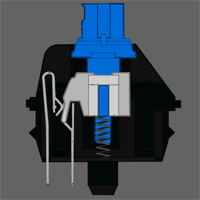
The Cherry MX Blue is the most common clicky switch, and was first made available in Filco keyboards in 2007. Blue switches are favoured by typists due to their tactile bump and audible click, but can be less suitable for gaming as the weighting is relatively high – 50 cN – and it is a bit harder to double tap, as the release point is above the actuation point. Blue switches are noticeably louder than other mechanical switches, which are already louder than rubber domes, so these switches can be a bit disruptive in close working conditions.
See Cherry MX Blue switches here >
Less common Cherry MX switches
While the four switches listed above are found on the vast majority of mechanical keyboards with Cherry switches, quite a few other variants exist as well. We'll cover these briefly.
-
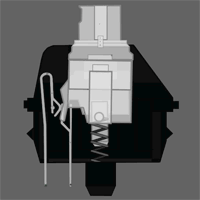 Silent Red (Pink) switches are quieter variants of the linear MX Red switch, with rubber pieces inside that dampen the sound of the switch returning to its default position. The actuation force remains 45 cN.
Silent Red (Pink) switches are quieter variants of the linear MX Red switch, with rubber pieces inside that dampen the sound of the switch returning to its default position. The actuation force remains 45 cN. - Speed Silver is a shortened version of the MX Red switch, actuating at 1.2mm instead of 2mm and with a total travel of 3.4mm compared to 4mm.
- Clear switches are a stiffer version of Brown switches, with a tactile bump and weighting of 65 cN.
- Grey switches are used for space bars on Clear keyboards, with a weighting of 80 cN.
- Green switches are a stiffer version of Blue switches, with a tactile bump and audible click, weighted at 80 cN. It is primarily used for space bars.
- White switches are very similar to green switches, with modern versions being weighted the same (80 cN) but being slightly quieter.
- Super Black switches are extra stiff (150 cN) linear switches designed for space bars on keyboards with Black switches.
- Dark Grey switches are moderately more stiff linear (80 cN) switches designed for use as space bars on keyboards with Cherry MX Black switches.
- Cherry MX Lock switches are locking linear switches that stay down until pressed again, typically used for Caps Lock and TTY lock in keyboards before the 1980s.
Conclusion
So there we have it – information on the various MX switches produced by Cherry and now ZF Electronics. I hope this has been useful – if you have any questions, feel free to share them in the comments below! You can also ask on Twitter or Facebook. Finally, if you'd like to pick up a few switches to play around with, then you can do so on our switches page. Thanks for reading and have a good one!
Animated Cherry MX images from Lethal Squirrel on Geekhack.org.
Source: https://www.keyboardco.com/blog/index.php/2012/12/an-introduction-to-cherry-mx-mechanical-switches/
0 Response to "Green 21v Blue 27v Red 33v"
Post a Comment